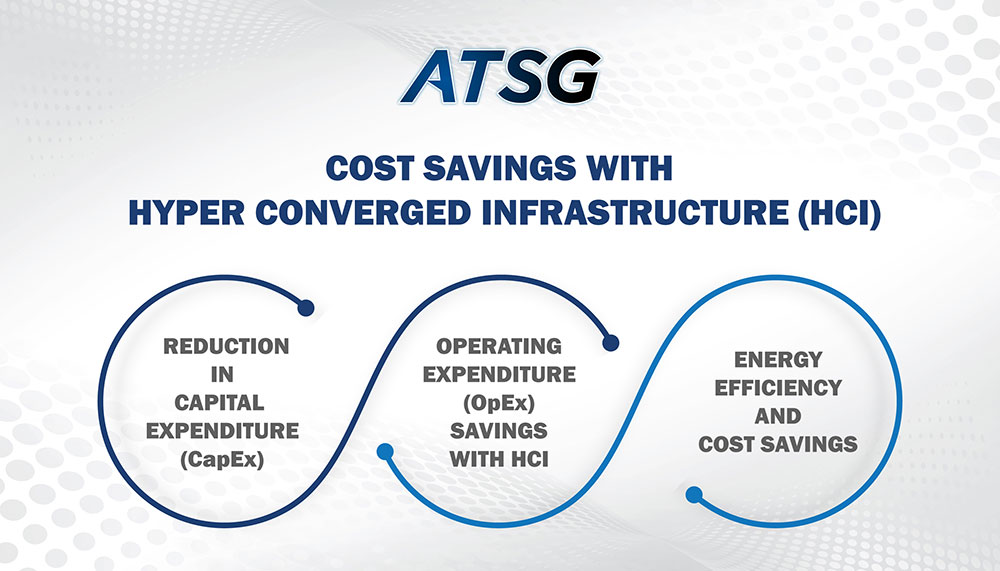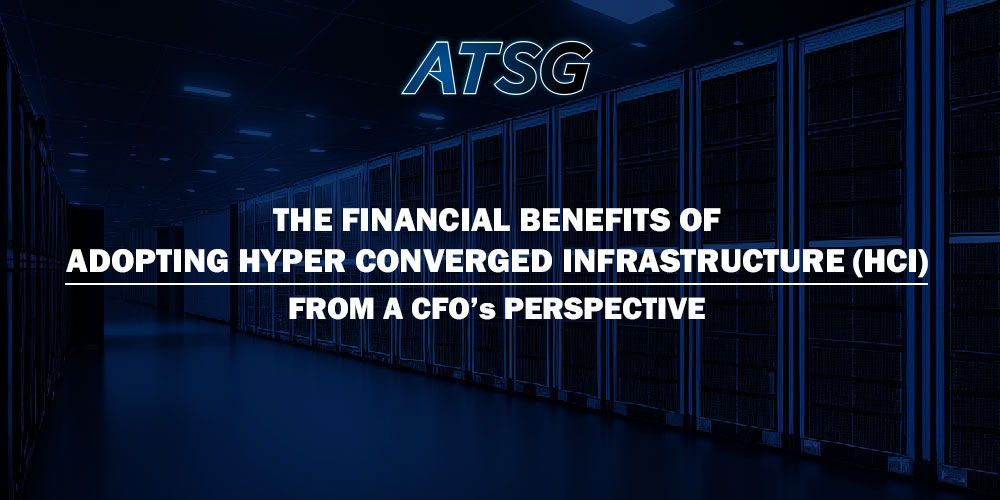What is Hyper Converged Infrastructure (HCI)?
Efficiency is key when it comes to modern enterprise operations and data center strategies. This is why hyperconvergence has become increasingly popular as a technology. By integrating storage, networking, and compute into a single infrastructure, management is simplified and streamlined.
The Key Components of HCI
This approach employs a distributed infrastructure plan, and a distributed management plan, resulting in faster overall results and improved data efficiency. The distributed infrastructure plan operates across a cluster of nodes, providing storage, virtualization, and networking services for guest applications and other workloads. The management plan oversees the global HCI resources, from a unified interface.
Data Center Evolution – from Converged to Hyperconverged
In the past, data center management was treated as a separate area of expertise, resulting in wasteful over-provisioning of resources by storage, server, and networking teams. This was normally done to meet un-anticipated future requests from service teams. However, with the proliferation of HCI, this particular issue has been addressed with an effective solution.
The Financial Perspective of HCI
The CFO’s Role in IT Investment Decisions
The foundation of technology investment decisions has not changed, but the priorities have shifted though. When it comes to adapting to these changes, Chief Financial Officers (CFOs) can support technology initiatives to reframe their problems, reiterate their financial support for newer technologies, and invest in innovative solutions that can enhance the Return on Investment (ROI) and attain business progression.
Evaluating the Total Cost of Ownership (TCO) of HCI
Certain factors need to be considered when it comes to evaluating the TCO of HCI. This particularly includes:-
- The initial cost of procuring HCI.
- Amount spent on the services or additional equipment.
- Additional costs regarding software and tools.
- Costs regarding scaling and upgrading.
- Time and cost of migrating to new platforms.
- Cost of space and storage in data center consumed.
- Power consumption of the added equipment.
- Ongoing management and maintenance costs.
- Additional costs of staffing.
Understanding the Return on Investment (ROI) of HCI
HCI solutions are growing in popularity for combining storage, network and compute components, with a hypervisor and management software to create a comprehensive architecture. In a lot of cases however, enterprises lack the in-house capacity and expertise to manage HCI environments. This is where Cloud Computing solutions can really come in, as a fully managed alternative.
Cost Savings with Hyper Converged Infrastructure (HCI)

Reduction in Capital Expenditure (CapEx)
HCI integrates all resources into a single platform, eliminating the need for separate hardware components for each function. This consolidation reduces the overall hardware footprint, which results in lower up-front capital expenditure and on-going maintenance costs as well.
Operating Expenditure (OpEx) Savings with HCI
HCI’s software-defined architecture allows for more efficient pooling and allocation of resources, leading to higher utilization rates, and better ROI on hardware investments. This results in better operational progress, with a welcome reduction in operational costs as well.
Energy Efficiency and Cost Savings
By consolidating resources and optimizing data center operations, HCI can lead to reduced power consumption and lower energy bills. With HCI, organizations can at times benefit from vendor-provided support and updates for the entire integrated system, reducing the need for individual hardware and software maintenance contracts.
Enhanced Business Value with HCI
Improved Organizational Agility
Another value addition of HCI is that IT teams can rapidly scale and adopt data center services, and the business as a whole can respond swiftly to changing market conditions in customer demand. This enables better customer experiences, reduced time to market, higher customer satisfaction, better corporate reputation, revenue and profitability.
Accelerating Time-to-Value with HCI
Organizations investing in HCI can recognize the value they can bring to their business and customers, by accelerating their speed-to-market. The technological advances of HCI can enable organizations to attain their goals at a faster pace, by reducing the lead time to convert a product or service idea into reality.
The Impact of Scalability on Business Growth
HCI adopts a modular approach to infrastructure deployment and management, allowing I&O leaders to simply add more capacity as and when required, non-disruptively, cutting deployment times and minimizing downtime. HCI’s extensive use of virtualization also enables a highly flexible data center architecture. It leverages virtualization to control and manage standard hardware resources more efficiently.
Risk Mitigation and HCI
Enhancing Data Protection and Disaster Recovery (DR)
Many HCI solutions offer built-in data protection features, such as data replication, snapshots (back-ups), and automated backups. HCI can improve an organization’s disaster recovery (DR) posture. With replication and failover features, organizations can create robust DR plans, and recover critical services and data more quickly, in the event of a disaster.
Compliance and Security Considerations in HCI
HCI vendors often provide security features, including encryption, secure boot, and role-based access controls (RBAC), to protect data and infrastructure from un-authorized access or tampering. HCI can aid in compliance efforts by providing centralized monitoring and auditing capabilities. This helps organizations demonstrate adherence to industry regulations, and resilient internal data governance policies.
Reduced Downtime and its Financial Payoff
HCI’s integrated backup and recovery features facilitate regular testing of backup integrity and recovery procedures, ensuring that organizations can confidently restore their data in case of emergencies. This protects the enterprise from facing any challenging situations that can drain expenses, and adversely impact the bottom line.
Making the Transition to HCI
Key Considerations for Adopting HCI
As technology has continued to develop, hyper-convergence has emerged as a more efficient model for a modern data center strategy. With HCI’s centralized IT features, such as storage, networking, and computing, enterprises can reduce their IT related operating overheads. The day-to-day management is vastly simplified and can often be streamlined further with the assistance of intelligent software tools.
Overcoming Potential Challenges in HCI Implementation
Every aspect of IT works together in a tightly integrated fashion for faster and better overall results. Understandably, there are certain challenges faced with every new IT solution that is integrated. With HCI, scalability isn’t normally a built-in feature, but is essential for organizations to reduce provisioning times and cost structures. Another notable advantage of hyper-convergence is its data efficiency, which can benefit an enterprise in multiple ways.
Partnering with the Right HCI Vendor
Not all solutions can guarantee this improvement in certain areas. However, making the move from legacy silos can allow organizations to enjoy the efficiencies of HCI. Nevertheless, whenever investing in any new technology or solution, it is vital for organizations to ensure they are partnering with the right vendor or service provider. Having a strong partnership with a service provider can mitigate challenges, and bring forward the ideal roadmap for the best possible solution.
The Future of HCI – A CFO’s Outlook
Emerging Trends in HCI
HCI has proven invaluable for enterprises in almost every scenario, from stagnant businesses to those shooting for astronomical growth. Regardless of the business or industry, HCI has been playing a huge role to integrate technology, and achieve successful digital transformation.
The Long-term Financial Implications of HCI
With hyper-converged infrastructure, organizations are better able to leverage cost-benefits, and economies of scale in business. While moving towards HCI models requires upfront investment, the cost-savings can make this upgrade worth it. Moreover, partnering with a well-established MSP that can assess the needs of its client enterprise, then design custom solutions, and support an efficient rollout can elevate the data center experience substantially.
HCI and the Future of Business Technology Management
As investments in Internet of Things (IoT) and smart devices increase, the spur of adopting HCI continues. The power and storage that hyper-convergence provides, in addition to the ease of manageability and scalability, will motivate enterprises to focus more on such innovative solutions.
As a leading provider of Managed IT Services and Intelligent Technology solutions, ATSG leverages Nutanix HCI, enabling us to deliver enterprise grade, highly resilient, scalable and effective Cloud Computing solutions as well as services.





